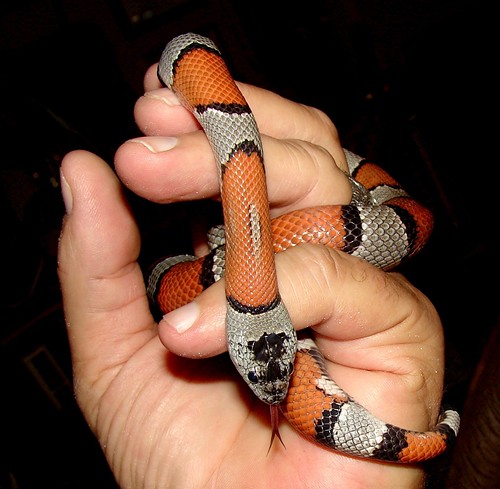The grey-banded kingsnake, (Lampropeltis alterna), or more commonly just referred to as the alterna, is a species of non-venomous colubrid snake, found in the Trans-Pecos/Chihuahuan Desert region of western Texas, southern New Mexico, and northern Chihuahua. Some sources list two distinct subspecies of alterna, L. a. alterna and L. a. blairi (Flury, 1950) differentiated by patterning and locale, but research has shown them to be the same.
Grey-banded kingsnakes are moderately sized snakes, rarely exceeding 46 inches, but specimens up to 57 inches have been recorded. They have a relatively wide head (when compared to other kingsnake species), and have large eyes with round pupils.
Alterna coloration and patterning varies greatly, but there are two main color morphs, which were once considered separate subspecies: the "Blairs" which has wide red/orange banding, and the "Alterna" which has thinner orange/red banding. Both are generally on a grey background with white and/or black accenting. There are many variations on this basic morophology found in the wild and captive bred, with some specimens even lacking orange or red banding entirely.
Grey-banded kingsnakes are moderately sized snakes, rarely exceeding 46 inches, but specimens up to 57 inches have been recorded. They have a relatively wide head (when compared to other kingsnake species), and have large eyes with round pupils.
Alterna coloration and patterning varies greatly, but there are two main color morphs, which were once considered separate subspecies: the "Blairs" which has wide red/orange banding, and the "Alterna" which has thinner orange/red banding. Both are generally on a grey background with white and/or black accenting. There are many variations on this basic morophology found in the wild and captive bred, with some specimens even lacking orange or red banding entirely.
In the wild, grey-banded kingsnakes are not often encountered. They are uncommon, nocturnal, and quite secretive. Their natural range is sparsely populated with humans and many regions are virtually impassable due to its mountainous terrain. In the field herpetologist community, finding one in the wild is often considered to be a laudable feat. Most that are located are found along the roadways that transect their habitat in the Trans Pecos region.
Alterna generally have a calm disposition and are not prone to defensive reactions, like biting. They feed primarily on lizards, rodents, and sometimes frogs.
Alterna are oviparous, laying clutches 3-13 eggs in early summer, which hatch in approximately 9 weeks. Hatchlings are around 10 inches in size.
Alterna generally have a calm disposition and are not prone to defensive reactions, like biting. They feed primarily on lizards, rodents, and sometimes frogs.
Alterna are oviparous, laying clutches 3-13 eggs in early summer, which hatch in approximately 9 weeks. Hatchlings are around 10 inches in size.



No comments:
Post a Comment